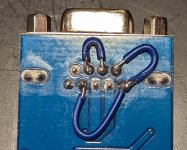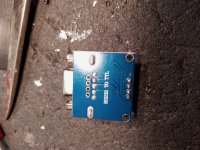Sort of a strange problem...
Equipment- Tandy 1000EX, Arcanebyte wifi modem, WiRSa wifi modem and Telix software.
About a year ago I got back into the BBS scene using my 1000EX and an Arcanebyte modem set to 9600 baud. I attach the two with an old 25 pin cable that I've probably had since the 80s. I've spent countless hours on it and it's always fast and flawless.
Recently I built a WiRSa modem. This one has a 9 pin connector, so I simply used a 9 to 25 adapter with the same cable. Works perfect just like the Arcanebyte.
The WiRSa has a case and really cool screen so I wanted to mount it to a shelf next to my monitor where it's visible. I ordered a 9 pin serial cable in black to match and streamline the looks (25 to 9 adapter on back of EX). With the new 9 pin cable, it operates painfully slow and locks up Telix every so often. If I drop to 4800, Telix no longer locks up, but it's still slow. Hook the 25 pin cable back up and WiRSa is blazing fast again.
I figure it's a bad cable, so I send it back to Amazon and order a different brand. New one is a bit faster than the last and it no longer locks up Telix at 9600, but it's still noticeably slower than the 25 pin. Arcanebyte also runs slower with this cable so I know it's nothing else with my setup.
I don't quite understand how a cable can affect speed? If the modem and serial port are set to 9600 baud, wouldn't that be a fixed output no matter what, and a poor cable would result in missed characters/garbage?
Cables are 6' and supposedly 28 gauge. I've also tried moving the cable away from CRT monitor and home router with no change.
Is it possible the extra wires in the 25 pin cable are acting as a shield and giving better performance?
At this point, I'm thinking of building my own and using shielded twisted pair (yes, I know it's technically not required) to see if it makes a difference.
Equipment- Tandy 1000EX, Arcanebyte wifi modem, WiRSa wifi modem and Telix software.
About a year ago I got back into the BBS scene using my 1000EX and an Arcanebyte modem set to 9600 baud. I attach the two with an old 25 pin cable that I've probably had since the 80s. I've spent countless hours on it and it's always fast and flawless.
Recently I built a WiRSa modem. This one has a 9 pin connector, so I simply used a 9 to 25 adapter with the same cable. Works perfect just like the Arcanebyte.
The WiRSa has a case and really cool screen so I wanted to mount it to a shelf next to my monitor where it's visible. I ordered a 9 pin serial cable in black to match and streamline the looks (25 to 9 adapter on back of EX). With the new 9 pin cable, it operates painfully slow and locks up Telix every so often. If I drop to 4800, Telix no longer locks up, but it's still slow. Hook the 25 pin cable back up and WiRSa is blazing fast again.
I figure it's a bad cable, so I send it back to Amazon and order a different brand. New one is a bit faster than the last and it no longer locks up Telix at 9600, but it's still noticeably slower than the 25 pin. Arcanebyte also runs slower with this cable so I know it's nothing else with my setup.
I don't quite understand how a cable can affect speed? If the modem and serial port are set to 9600 baud, wouldn't that be a fixed output no matter what, and a poor cable would result in missed characters/garbage?
Cables are 6' and supposedly 28 gauge. I've also tried moving the cable away from CRT monitor and home router with no change.
Is it possible the extra wires in the 25 pin cable are acting as a shield and giving better performance?
At this point, I'm thinking of building my own and using shielded twisted pair (yes, I know it's technically not required) to see if it makes a difference.


